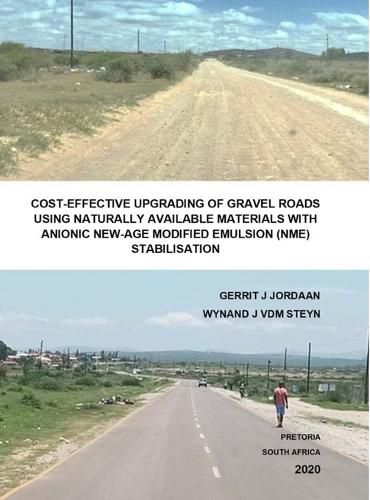Readings Newsletter
Become a Readings Member to make your shopping experience even easier.
Sign in or sign up for free!
You’re not far away from qualifying for FREE standard shipping within Australia
You’ve qualified for FREE standard shipping within Australia
The cart is loading…






This title is printed to order. This book may have been self-published. If so, we cannot guarantee the quality of the content. In the main most books will have gone through the editing process however some may not. We therefore suggest that you be aware of this before ordering this book. If in doubt check either the author or publisher’s details as we are unable to accept any returns unless they are faulty. Please contact us if you have any questions.
A reliable road network is a pre-requisite for economic development. However, the provision of all-weather transportation infrastructure (roads) in developing areas, using traditional design approaches, currently comes at a considerable cost. The construction of a low-volume two lane road in rural and urban areas in Africa may vary from about US$ 500 000/km (2018) in more developed areas, to US$ 1.2 million/km rural areas, to more in remote areas as influence by material, logistics and safety risks. A general lack of available funds and lack of resources allocated for road infrastructure development is a reality. The current surfaced road network backlog, the lack of resources and the high unit costs make it basically impossible for the Developing World to provide the road infrastructure required to become economically competitive. The high unit costs can be addressed through a change in current engineering practices and the implementation of available and proven new technologies. New-age nanotechnology solutions are available to improve the characteristics of naturally available materials to meet the structural engineering requirements for all road pavement layers. These technologies have been proven through laboratory, full scale Accelerated Pavement Tests (APT) tests and practical implementation. The hydrophobic (water-repellent) action achieved through the stabilisation of pavement layers using anionic NME stabilisation agents, to a large extend prevents (or at least considerably retards) water from entering pavement layers and causing distress due to a change in the shear strength of the materials in the pavement structure. This book provides a comprehensive approach towards the upgrading of gravel / soil roads using naturally available materials stabilised and improved with anionic New-age Modified Emulsions (NME). The aim is to provide all-weather surface roads at an affordable costs, incorporating the best available technologies. This can be achieved without compromising the integrity of the road pavement structure and / or the safety of road users. Applicable standards together with the implementation of the latest proven developments in material sciences makes this a reality.
$9.00 standard shipping within Australia
FREE standard shipping within Australia for orders over $100.00
Express & International shipping calculated at checkout
This title is printed to order. This book may have been self-published. If so, we cannot guarantee the quality of the content. In the main most books will have gone through the editing process however some may not. We therefore suggest that you be aware of this before ordering this book. If in doubt check either the author or publisher’s details as we are unable to accept any returns unless they are faulty. Please contact us if you have any questions.
A reliable road network is a pre-requisite for economic development. However, the provision of all-weather transportation infrastructure (roads) in developing areas, using traditional design approaches, currently comes at a considerable cost. The construction of a low-volume two lane road in rural and urban areas in Africa may vary from about US$ 500 000/km (2018) in more developed areas, to US$ 1.2 million/km rural areas, to more in remote areas as influence by material, logistics and safety risks. A general lack of available funds and lack of resources allocated for road infrastructure development is a reality. The current surfaced road network backlog, the lack of resources and the high unit costs make it basically impossible for the Developing World to provide the road infrastructure required to become economically competitive. The high unit costs can be addressed through a change in current engineering practices and the implementation of available and proven new technologies. New-age nanotechnology solutions are available to improve the characteristics of naturally available materials to meet the structural engineering requirements for all road pavement layers. These technologies have been proven through laboratory, full scale Accelerated Pavement Tests (APT) tests and practical implementation. The hydrophobic (water-repellent) action achieved through the stabilisation of pavement layers using anionic NME stabilisation agents, to a large extend prevents (or at least considerably retards) water from entering pavement layers and causing distress due to a change in the shear strength of the materials in the pavement structure. This book provides a comprehensive approach towards the upgrading of gravel / soil roads using naturally available materials stabilised and improved with anionic New-age Modified Emulsions (NME). The aim is to provide all-weather surface roads at an affordable costs, incorporating the best available technologies. This can be achieved without compromising the integrity of the road pavement structure and / or the safety of road users. Applicable standards together with the implementation of the latest proven developments in material sciences makes this a reality.